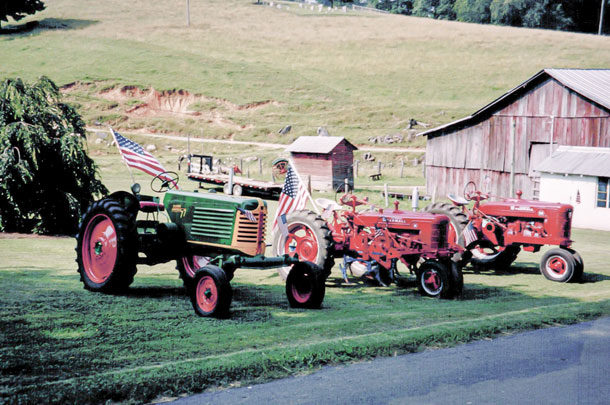The Farmall H in the center belongs to our longtime neighbor and family friend, Andrew. It has quite a history of its own, and it’s nice to find another old tractor that has been in the same family since it was bought new.
The 1945 Farmall M was the very first tractor in our collection. Even though a Farmall M is one of the most common tractors, with over 270,000 built, I still can’t imagine our collection without it. Dad found it sitting on a vacant lot in downtown Kingsport, Tennessee, around 1996. After several phone calls, he finally tracked down the owner and was able to buy it. Our buddy Jader hauled it home for us with his ’70s model Ford ton truck and a tag-along trailer.
As soon as we got the M unloaded, we went straight to work on getting it running. The engine wasn’t stuck, so at least we had that in our favor. I can remember us pulling it around the barnyard with the 135 Massey Ferguson and it popping, cracking, backfiring and sputtering as it took a while to “clear the cobwebs” and get it straightened out, but we finally got it going. After a couple years of running and using the M in its “work clothes” (original condition), Dad decided it was time to sandblast and paint it.
After a lot of work, new rear tires, and several new parts, it was time to pick it up from our friend Danny’s paint shop. I think I was a senior in high school at the time, and I went to get it one afternoon after school. It looked great, and I was so proud to haul it through town on the way home. I really wanted Andrew to see the finished product, as he had been a great help in getting it running and tuning it when we first got it, so I took it straight to his house. I think he liked it pretty well because he decided (or I talked him into it) that we should drag his old Farmall H out of the ridge that very evening.
I had heard of this tractor and how it was left sitting outside in disrepair for so many years. At one time, it was stored in a barn in running condition on his other farm that joined ours, but one year somebody pulled it outside to hang tobacco and didn’t bother to cover the exhaust pipe. Then, somebody thought it would be cute to stomp and break the valve stems off the rear tires, allowing the calcium chloride to leak out and ruin the rims. Needless to say, by the time Andrew realized what had happened, the engine was already stuck, and the damage was done.
It was closer to take the H to our shop, so we went right to work that night to find out just how bad the damage was to the engine. We pulled the head off, and it was obvious the block was busted and a complete engine rebuild with a good block was needed. After a full summer’s work and a whole lot of learning for me (and busted knuckles), we were ready to fire it up. Man, did it sound good. There’s nothing like cranking and bringing an old tractor back to life, especially one that seemed to be so far gone.
Thankfully, we were able to get it out of the shop and drive it to show Andrew’s dad, J.P., not long before he passed away. He didn’t say much, but I could see the satisfaction he got from hearing the tractor run again that he had bought new and farmed with for so many years. There were countless stories told about this special H during the restoration process, as well as their Louisville Super M – fond memories of a tractor that meant so much to this family.
The 1949 Oliver 77 was the first running Oliver added to the collection, aside from the two Oliver Hart-Parr 70 tractors that were only good for a few parts at best. We bought it at an auction that used to be held in conjunction with a local annual tractor show. We’ve never really done any cosmetic work to the 77, but early on it had some electrical issues. We addressed all that and got the lights working, and added a new steering wheel and a new temperature gauge. Overall, it’s been a very reliable machine, a great parade tractor, and I’ve even tractor-pulled it a few times.
I had taken the M and the 77 to work with me to display at the Washington County Virginia Fair the morning of Sept. 11, 2001. After the terrible events of that day, I wasn’t even sure the fair would go on, but they decided to go ahead. I have a great photo of the two tractors proudly waving American flags, which hopefully provided a little encouragement to folks during a time of such tremendous hurt and despair.
There are so many great memories of all three of these tractors. I have learned so many lessons and gained so much valuable knowledge from growing up with and working on these great machines. I’m very thankful for all those who have taken the time to teach me along the way. Hopefully, I’ll be able to teach my son and others about old iron, and interest in this hobby will stay alive and well for many years to come. ![]()
PHOTO: My dad’s 1949 Oliver 77 (left), our friend Andrew’s restored Farmall H with full cultivators (middle), and our first tractor, the beloved 1945 Farmall M (right). Also pictured is the gooseneck trailer I bought a few days after graduating high school (without Dad’s permission), the tip-toe steel rear wheels of an Oliver Hart-Parr 70 peeking out from behind the corn crib, our burley tobacco barn (tractor shed) and the old milk house. Photo by Lance Phillips.










